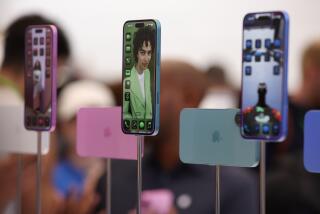Waiting for Apple’s iWatch
With Apple’s stock hobbling and questions lingering about its ability to innovate in the post-Steve Jobs era, investors and fans are latching on to hopes that the tech giant’s next big thing will be the iWatch.
While little is known of the mythical gadget that has recently become the hottest topic of Silicon Valley’s rumor mill, boosters envision a device that would let users read emails, Facebook notifications or caller ID by simply glancing down at their wrists.
The smartwatch, connected wirelessly to the iPhone, would tap the power of the voice assistant Siri to control music, dictate messages or get directions. Forget the wallet? Just swipe the watch near a scanner to make a payment. And as you jog home later, the kinetic energy of your movement would keep the battery charged while the iWatch measures your heart rate and the distance covered.
“It would transform the whole smartphone business and the whole watch business at the same time,” said Marshal Cohen, chief industry analyst for consumer research firm NPD Group. “And for the better.”
It would do all this and more. If it exists.
For despite all the speculation about Apple’s plans, nobody really knows what features it might include, and when Apple might release it.
And yet, this being Apple, such a watch, imagined or real, already faces monstrously high expectations. For Apple, there’s a big risk that releasing a watch that fails to dazzle, or that falls short of the iFantasyWatch people have in their heads, could hurt its reputation for innovation and raise fresh questions about the company’s ability to develop products without its late co-founder Jobs.
Veterans of the smartwatch game caution that current technology severely limits the features such a watch could offer, not to mention the difficulty of getting a complex mix of specs just right.
“Apple brings a lot of cachet to the conversation, but success in this category will be about cool design as much as technology,” said Bill Geiser, chief executive of Meta Watch, who has been working on smartwatches for more than a decade. “You have a very small space for the device that is largely constrained. The design of any smartwatch is driven by anatomy, and it’s driven by fashion and it’s driven by battery life.”
There is no question that Apple is looking seriously at wearable computing, and most likely something for the wrist. In recent weeks, several news outlets, including Bloomberg, have cited sources indicating that such a product is on its way. The financial news agency reported that at least 100 employees are working on a watch.
As is typical, Apple has declined to discuss any plans for future products. Over the last decade, the company has filed applications and received numerous patents for technologies related to watch-like devices, including at least 79 that mention the word “wrist,” according to Bloomberg.
In late February, the U.S. Patent and Trademark Office revealed a patent application from Apple for a wearable computer in the form of a flexible bracelet that wraps around the wrist. According to the filing, that gadget would include a multi-touch display that would enable the user to “accomplish a number of different tasks including adjusting the order of a current playlist, or reviewing a list of recent phone calls. A response to a current text message can even be managed given a simple virtual keyboard configuration across the face of the flexible display.”
Another patent, filed by Apple in 2009 and awarded in February, describes a “personal items network, and associated methods.” The patent outlines what Apple calls “movement” or “event monitoring devices” (MMD or EMD) that include sensors and transmitters and an accelerometer to record things like heart rate, pulse, stress, outside temperature or other environmental conditions. The patent includes a drawing of one such device taped to a person’s wrist.
Putting this all together, an Apple iWatch could combine some aspects of a phone but also health monitoring devices such as Nike Inc.’s FuelBand. And there are plenty of folks who are convinced that such a device represents a massive opportunity not just for Apple, but also for numerous competitors.
“The combination of technologies naturally opens up the opportunity for a body area network to become a reality,” said Geiser, whose firm sells watches that work with both Apple and Android phones. “And the wrist is beachfront property.”
Apple already has gotten a glimpse of just how eager some people are for the company to make a watch. In 2010, the company released the sixth generation of its iPod Nano that shrank the device from a long rectangle to a small square that was almost all screen. People immediately made wristbands to strap Nanos to their wrists.
Scott Wilson, a designer who lives in Chicago, had been working on smartwatches for years. When he saw the new iPod Nano, he thought “watch” and designed some straps for it and sold them through a company he started called LunaTik.
“When they showed the size, and it was so small, it was interesting because all the smartwatches to date had been too big and clunky to make it a mass market,” Wilson said. “With the Nano, it was like, ‘Wow, look what they packed into this tiny package.’”
Last year, Apple released the seventh-generation Nano, which returned to a rectangular shape, undercutting its usefulness as an improvised watch. Wilson isn’t sure whether Apple wanted to stop a budding watch business it wasn’t ready to serve. But he said he continues to talk to friends at Apple who say a watch is coming — eventually.
“It’s not a question of if Apple will do a smartwatch,” Wilson said. “It’s when. Apple is good at not being first. They wait until technology doesn’t compromise their vision.”
That was the case with tablet computing. Analysts have noted that the company was looking at tablets as far back as 2004. But under Jobs, Apple decided to put them aside, believing the cost and power of the components were not right, wireless networks were not robust enough and consumers might not be ready for touch-screen computing.
That patience paid off when the company finally unveiled the iPad in 2010, not just the right product, but also at the right time.
Apple Chief Executive Tim Cook, in recent remarks at a shareholders meeting, seems to be indicating that Apple is still focused on making a product great, not just on getting something out the door to please investors.
“At Apple, it’s important to us that we make products that customers not just like, but love,” Cook said.
Because of the size and technological limits, Apple would have to make a number of difficult decisions about trade-offs.
For instance, smartwatch designers believe people want their watches to always be on for convenience. But that drains the battery faster. And because watches are also a personal fashion statement, Apple would have to decide whether to stick to its typical approach of offering a limited number of choices (a black or white watch?) or offer unlimited ways to customize the look.
For all the geeky goodness that could be packed into a watch, Apple would also have to thoroughly understand what draws people to any kind of watch.
Contrary to what you may have heard, smartphones are not killing the watch business. In fact, although the traditional watch industry has taken a licking in the last decade, it has done more than just tick.
According to NPD, sales of “fashion and sports watches” (watches under $350) grew to $1.9 billion for women and to $2.8 billion for men last year — up 18% and 12%, respectively, compared with 2011.
Cohen of NPD says this resurgence has taken hold in large part because younger consumers like the analog look and feel, not because of new features. As an ongoing experiment, Cohen says, he likes to approach teenagers wearing a watch and ask them what time it is. They almost always pull a phone out of their pocket to check, he says.
“The watch business is doing well because the younger generation is buying them as a fashion item,” he said.
Even assuming Apple nails this form factor, it remains unclear how many people really want such a gadget that, at least for now, would be an accessory to a phone, rather than a replacement.
In a recent note to investors, Morgan Stanley analyst Katy Huberty estimated that if Apple could eventually sell 50 million iWatches annually, that could generate $10 billion to $15 billion in new revenue, a nice bump for a company that reported $156.5 billion in revenue last year. What’s more, Huberty is convinced that the profit margin on such watches could be higher on a percentage basis than another long-rumored Apple product, a television set.
But Cohen says it might be a stretch to believe that Apple (or anyone) is going to create a mass market for a watch that merely is an extension of the user’s phone. The key to making a must-have gadget is creating something that feels indispensable. In the case of smartwatches, that something might have to be a device that doesn’t just extend a phone but replaces it.
“If you left your home, and you left your smartphone and had to drive 20 minutes, would you go back and get it? Yes,” Cohen said. “If you forgot your belt, or you forgot your watch? No. If I created a product that made you as passionate about your watch as you are about your smartphone, that gives you information that gets you through your day, that’s when you know you’ve a made a mass market. The latter is a game changer. The former is an accessory.”
More to Read
Inside the business of entertainment
The Wide Shot brings you news, analysis and insights on everything from streaming wars to production — and what it all means for the future.
You may occasionally receive promotional content from the Los Angeles Times.











